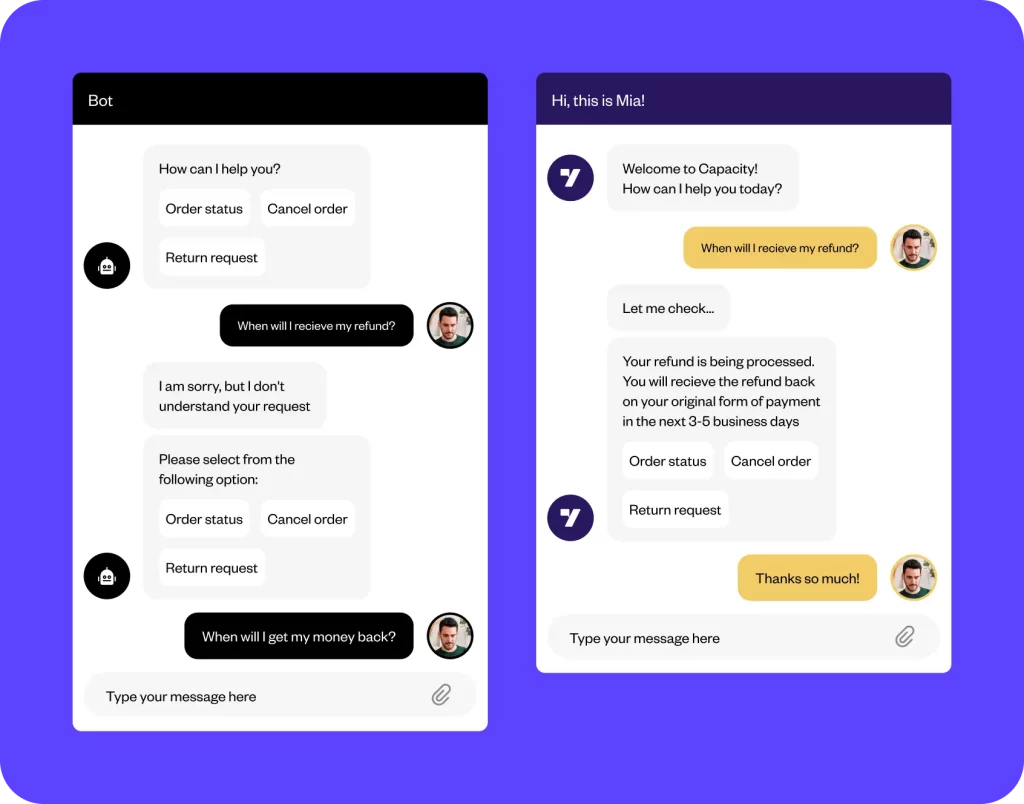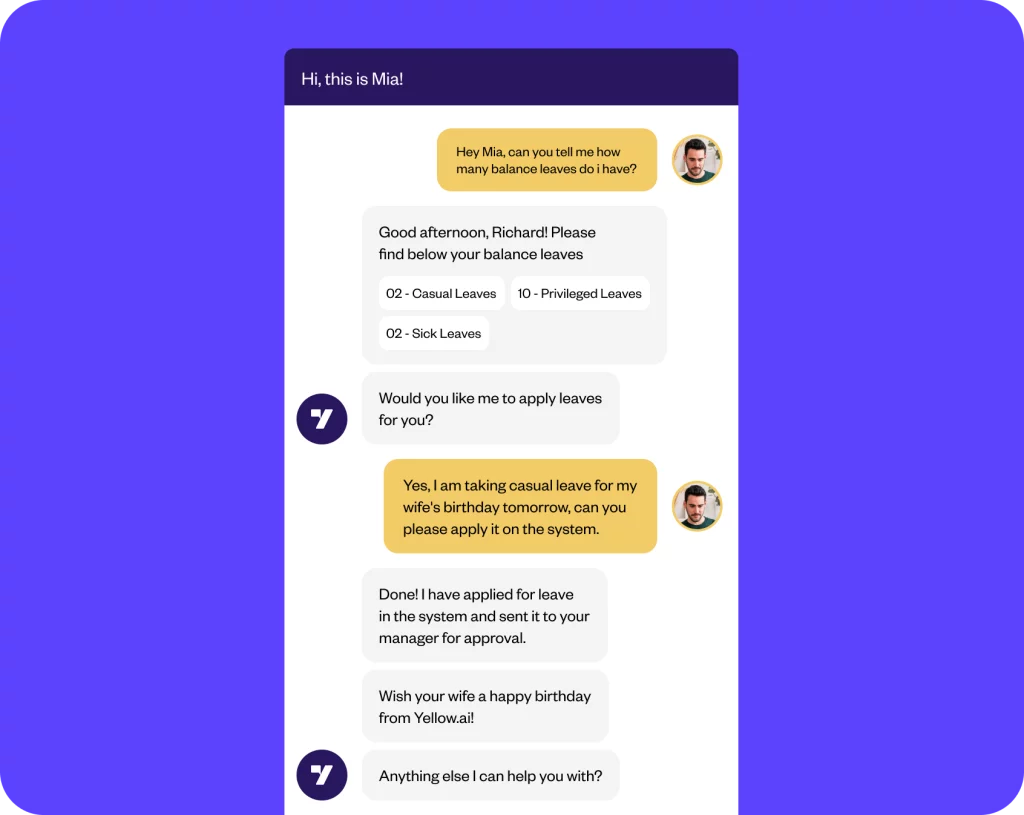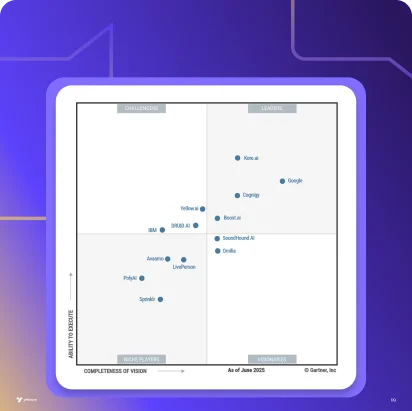Chatbots and conversational AI are often used interchangeably, but they’re not quite the same thing. Think of basic chatbots as friendly assistants who are there to help with specific tasks. They follow a set of predefined rules to match user queries with pre-programmed answers, usually handling common questions. However, it’s important to be aware of their limitations.
If you ask a basic chatbot something outside of its programmed knowledge, it may respond with a generic “Sorry, I don’t understand.” But there’s a whole world of conversational AI beyond basic chatbots, where intelligent systems can understand and respond to human language in a more sophisticated manner.
Now, let’s begin by setting the stage with a few definitions, and then we’ll dive into the fascinating world of chatbots and conversational AI. Together, we’ll explore the similarities and differences that make each of them unique in their own way.
What are chatbots?
Chatbots are software applications that are designed to simulate human-like conversations with users through text. They use natural language processing to understand an incoming query and respond accordingly. Traditional chatbots are rule-based, which means they are trained to answer only a specific set of questions, mostly FAQs, which is basically what makes them distinct from conversational AI.

Businesses worldwide are increasingly deploying chatbots to automate user support across channels. However, a typical source of dissatisfaction for people who interact with bots is that they do not always understand the context of conversations. In fact, according to a report by Search Engine Journal, 43% of customers believe that chatbots need to improve their accuracy in understanding what users are asking or looking for.
On the other hand, because traditional, rule-based bots lack contextual sophistication, they deflect most conversations to a human agent. This will not only increase the burden of unresolved queries on your human agents but also nullify the primary objective of deploying a bot.
Related must-reads:
- 9 Best chatbot examples for businesses by industry [2024]
- Customer service chatbots: Benefits and examples [2023]
- How to create a chatbot – Best practices to follow in 2023
- 30 Chatbot applications from six key industries
- Enterprise Chatbot – A Guide for Enterprises [2023]
- Benefits of AI Chatbots for Businesses and Customers
What is conversational AI chatbot?
Conversational AI refers to the technology that integrates artificial intelligence, natural language processing (NLP), and machine learning (ML) to make chatbots smarter and capable of having more human-like conversations. Conversational AI agents get more efficient at spotting patterns and making recommendations over time through a process of continuous learning, as you build up a larger corpus of user inputs and conversations.
According to an MIT Technology Review report, more than 90% of businesses reported that they had seen significant improvements in complaint resolution, call processing, and customer and employee satisfaction with conversational AI chatbots. Conversational AI is enabling businesses to deliver more personal experiences to their users by having more fluid and intelligent conversations. Artificial intelligence, with its capabilities of comprehending natural language, active learning, dialogue flow management, and data mining, helps transform and automate end-to-end user journeys
Related read- Conversational AI: A complete guide for AI bot solution [2023]
Chatbots Vs Conversational AI
Chatbots and conversational AI are often discussed together, but it’s essential to understand their differences.
Chatbots are like knowledgeable assistants who can handle specific tasks and provide predefined responses based on programmed rules. Conversational AI, on the other hand, takes chatbots to the next level. It combines artificial intelligence, natural language processing, and machine learning to create more advanced and interactive conversations.
Gaining a clear understanding of these differences is essential in finding the optimal solution for your specific requirements.
| Traditional Chatbots | Conversational AI Chatbot |
| Capable of text only commands, inputs, and outputs | Capable of voice and text commands, inputs and outputs |
| Single channel: can be used as a chat interface only | Omnichannel: can be deployed on websites, voice assistants, smart speakers, and call centers |
| Pre-determined scripted conversational flow | Natural language processing, understanding and contextualization |
| Rule-based, canned linear interactions. Cannot handle out of scope tasks | Wide-scope, non-linear, dynamic interactions |
| Navigational focused | Dialogue focused |
| Any update or revision to the pre-defined rules and conversational flow demands reconfiguration | Continual learning and fast iteration cycles |
| Manual maintenance, updates and revisions = difficult and time-consuming to scale | Highly scalable. As the company’s database and pages are updated, so does the conversational Al interface |
| Time-consuming and complicated building process | Easy deployment and integration with existing databases, text corpora |
Use cases for chatbot vs. conversational AI in customer service?
The goal of chatbots and conversational AI is to enhance the customer service experience. Chatbot responds with predefined answers based on programmed rules. However, conversational AI offers a more advanced and dynamic approach, enabling more natural, personalized, and intelligent conversations with customers, and has proven to offer significantly improved CX and reduced costs over traditional chatbots.
Let’s dive into some real-life scenarios where chatbots and conversational AI shine in customer service:
Chatbot use cases in customer service:
1. Basic FAQs
Your customer is browsing an online store and has a quick question about the store’s hours or return policies. Instead of searching through pages or waiting for a customer support agent, a friendly chatbot instantly assists them. It quickly provides the information they need, ensuring a hassle-free shopping experience.
2. Appointment scheduling
Imagine your customer is looking to book an appointment at a popular salon. Rather than navigating complex phone menus or waiting on hold, the chatbot steps in to simplify the process. It guides them through available time slots, gathers necessary details, and confirms their appointment with ease.
3. Order status updates
A customer of yours has made an online purchase and is eagerly anticipating its arrival. Instead of repeatedly checking their email or manually tracking the package, a helpful chatbot comes to their aid. It effortlessly provides real-time updates on their order, including tracking information and estimated delivery times, keeping them informed every step of the way.
4. Automated support
We’ve all encountered routine tasks like password resets, balance inquiries, or updating personal information. Rather than going through lengthy phone calls or filling out forms, a chatbot is there to automate these mundane processes. It can swiftly guide us through the necessary steps, saving us time and frustration.
Conversational AI chatbot use cases in customer service:
1. Personalized product recommendations
Conversational AI steps in as your virtual shopping assistant, analyzing your customers’ preferences and previous purchases. It understands their unique taste and provides personalized product recommendations, helping them discover new items tailored to their interests.
How Yellow.ai does it
Yellow.ai’s Conversational Commerce Cloud helps businesses optimize conversions at each stage, you can improve overall customer engagement by a significant 60% while enhancing customer experiences, fostering loyalty, and driving business growth and dramatically cutting down costs.
That’s not all, with innovative features like event-triggered workflows and user lifecycle optimizer, you can take date your friend to open up new revenue opportunities and drive outcomes!
2. Complex issue resolution
Picture a customer of yours encountering a technical glitch with a newly purchased gadget. Frustration sets in as they try to find a solution. In this situation, conversational AI systems come to the rescue. They possess the intelligence to troubleshoot complex problems, providing step-by-step guidance and detailed product information.
How Yellow.ai does it
Yellow.ai offers AI-powered agent-assist that will effortlessly manage customer interactions across chat, email, and voice with generative AI-powered Inbox. It also features advanced tools like auto-response, ticket summarization, and coaching insights for faster, high-quality responses.
3. Natural language understanding
Customers reach out to different support channels with a specific inquiry but express it using different words or phrases. Conversational AI systems are equipped with natural language understanding capabilities, enabling them to comprehend the context, nuances, and variations in your queries. They respond with accuracy as if they truly understand the meaning behind your customers’ words.
How Yellow.ai does it
With the cutting-edge technology of zero-shot learning, Yellow.ai’s proprietary NLP model – DynamicNLPTM revolutionizes the enterprise conversational AI landscape, enabling you to launch your solution within minutes without the need for extensive NLP training. What sets DynamicNLPTM apart is its extensive pre-training on billions of conversations, equipping it with a vast knowledge base. This extensive training empowers it to understand nuances, context, and user preferences, providing personalized and contextually relevant responses.
Also, with exceptional intent accuracy, surpassing industry standards effortlessly, DynamicNLPTM is adaptable across various industries, ensuring seamless integration regardless of your business domain. It has fluency in over 135+ languages, allowing you to engage with a diverse global audience effectively.
4. Emotional support and empathy
Sometimes, customers may seek more than just information or solutions. During difficult situations, such as dealing with a canceled flight or a delayed delivery, conversational AI can offer emotional support while also offering the best possible resolutions. It can be designed to exhibit empathy, understand your concerns, and provide appropriate reassurance or guidance.
How Yellow.ai does it
Yellow.ai revolutionizes customer support with dynamic voice AI agents that deliver immediate and precise responses to diverse queries in over 135 global languages and dialects.
The voice AI agents are adept at handling customer interruptions with grace and empathy. They skillfully navigate interruptions while seamlessly picking up the conversation where it left off, resulting in a more satisfying and seamless customer experience.
Additionally, with higher intent accuracy, Yellow.ai’s advanced Automatic Speech Recognition (ASR) technology comprehends multiple languages, tones, dialects, and accents effortlessly. The platform accurately interprets user intent, ensuring unparalleled accuracy in understanding customer needs.
Benefits of conversational AI over traditional chatbots
Conversational AI brings a host of business-driven benefits that prioritize customer satisfaction, optimize operations, and drive growth. With its ability to generate and convert leads effectively, businesses can expand their customer base and boost revenue.
Related read: Conversational IVR – Why do businesses need voice automation?
1. Advanced natural language understanding
Traditional chatbots operate within a set of predetermined rules, delivering answers based on predefined keywords. They have limited capabilities and won’t be able to respond to questions outside their programmed parameters.
Conversational AI, on the other hand, brings a more human touch to interactions. It is built on natural language processing and utilizes advanced technologies like machine learning, deep learning, and predictive analytics. Conversational AI learns from past inquiries and searches, allowing it to adapt and provide intelligent responses that go beyond rigid algorithms.
Think of traditional chatbots as following a strict rulebook, while conversational AI learns and grows, offering more dynamic and contextually relevant conversations. Conversational AI is more dynamic which makes interactions more personalized and natural, mimicking human-like understanding and engagement. It’s like having a knowledgeable companion who can understand your inquiries, provide thoughtful responses, and make your conversations more meaningful and enjoyable.
2. Contextual maturity
There is only so much information a rule-based bot can provide to the customer. If they receive a request that is not previously fed into their systems, they will be unable to provide the right answer which can be a major cause of dissatisfaction among customers.
Conversational AI, on the other hand, focuses on the prior discussions, chats, enquiries, transactions, and history of the consumer and, based on the same, makes tailored suggestions. The contextual awareness makes the customer even more satisfied and loyal. In fact, research suggests that 56% of customers stay loyal to brands which “get them.”

3. Multi-intent cognition
There is no one-size-fits-all answer to all questions. For example, if a customer wants to know if their order has been shipped as well how long it will take to deliver their particular order. A rule-based bot may only answer one of those questions and the customer will have to repeat themselves again. This might irritate the customer, as they didn’t get the info they were looking for, the first time.
On the contrary, conversational AI platforms can answer requests containing numerous questions and switch from topic to topic in between the dialogue. Because the user does not have to repeat their question or query, they are bound to be more satisfied. In fact, advanced conversational AI can deduce multiple intents from a single sentence and response addresses each of those points.
4. Integration, scalability, accuracy and consistency
Chatbots, although much cheaper, largely give our scattered and disconnected experiences. They are often implemented separately in different systems, lacking scalability and consistency. When you switch platforms, it can be frustrating because you have to start the whole inquiry process again, causing inefficiencies and delays.
Conversational AI solutions, on the other hand, bring a new level of coherence and scalability. They ensure a consistent and unified experience by seamlessly integrating and managing queries across various social media platforms. With conversational AI, businesses can establish a strong presence across multiple channels, providing customers with a seamless experience no matter where they engage.
In simpler terms, conversational AI offers businesses the ability to provide a better overall experience. It eliminates the scattered nature of chatbots, enabling scalability and integration. By delivering a cohesive and unified customer journey, conversational AI enhances satisfaction and builds stronger connections with customers.
Case study: Domino’s cooks up delightful omnichannel customer experience with Yellow.ai
5. Multilingual capabilities and voice assistance
When compared to conversational AI, chatbots lack features like multilingual and voice help capabilities. The users on such platforms do not have the facility to deliver voice commands or ask a query in any language other than the one registered in the system.
Siri, Google Assistant, and Alexa all are the finest examples of conversational AI technologies. They can understand commands given in a variety of languages via voice mode, making communication between users and getting a response much easier.
The Future of Chatbots vs. Conversational AI
To say that chatbots and conversational AI are two different concepts would be wrong because they’re very interrelated and serve similar purposes. While chatbots are computer programs that automate text- and voice-based communication and customer service and serve as virtual support agents, conversational AI is the technology that fuels the creation of these human-like customer service virtual agents.
Due to this, many businesses are adopting the conversational AI approach to create an interactive, human-like customer experience. A recent study suggested that due to COVID-19, the adoption rate of automation and conversational interfaces went up to 52%, indicating that many companies are embracing this technology. This percentage is estimated to increase in the near future, pioneering a new way for companies to engage with their customers.
Chatbot vs. Conversational AI – Which is best for your business?
If you have a complex use case, conversational AI is the best way to go. Sometimes, people think for simpler use cases going with traditional bots can be a wise choice. However, the truth is, traditional bots work on outdated technology and have many limitations. Even for something as seemingly simple as an FAQ bot, can often be a daunting and time-consuming task.
Organizations have historically faced challenges such as lengthy development cycles, extensive coding, and the need for manual training to create functional bots. However, with the advent of cutting-edge conversational AI solutions like Yellow.ai, these hurdles are now a thing of the past.
Yellow.ai’s revolutionary zero-setup approach marks a significant leap forward in the field of conversational AI. With YellowG, deploying your FAQ bot is a breeze, and you can have it up and running within seconds.
The best part is that it uses the power of Generative AI to ensure that the conversations flow smoothly and are handled intelligently, all without the need for any training.
Experience the power of Generative AI

Frequently asked questions (FAQs)
What are the 4 types of chatbots?
The four types of chatbots are:
The four types of chatbots are Rule-based chatbots, AI-powered chatbots, Virtual agents Voice-activated chatbots
1. Rule-based chatbots: These chatbots operate on a set of predefined rules and respond based on specific keywords or patterns. They are limited in their capabilities and cannot handle complex queries outside their programmed rules.
2. AI-powered chatbots: These chatbots incorporate artificial intelligence technologies, such as natural language processing (NLP) and machine learning (ML). They can understand and respond to user queries more intelligently, learning from interactions and improving over time.
3. Virtual agents: Also known as intelligent chatbots, virtual agent bots are designed to perform more advanced tasks. They can handle natural language conversations, provide personalized recommendations, and perform tasks like scheduling appointments or making reservations.
4. Voice-activated chatbots: These chatbots are specifically designed to interact with users through voice commands. They use speech recognition technology to understand and respond to verbal instructions, enabling hands-free interactions.
Is conversational AI part of NLP?
Yes, conversational AI is a part of Natural Language Processing (NLP). NLP is a subfield of artificial intelligence that focuses on enabling machines to understand, interpret, and generate human language. It involves tasks such as speech recognition, natural language understanding, natural language generation, and dialogue systems.
Conversational AI specifically deals with building systems that understand human language and can engage in human-like conversations with users. These systems can understand user input, process it, and respond with appropriate and contextually relevant answers. Conversational AI technology is commonly used in chatbots, virtual assistants, voice-based interfaces, and other interactive applications where human-computer conversations are required. It plays a vital role in enhancing user experiences, providing customer support, and automating various tasks through natural and interactive interactions.
What are the types of conversational AI?
Here are three main types of conversational AI:
AI chatbots: These conversational AI programs simulate human-like messaging interactions and can be integrated into various platforms, including social media, websites, and mobile apps, to resolve customer requests efficiently. They excel at delivering information and assisting users with administrative tasks, making them valuable for enhancing customer support and engagement.
Voice bots: Voice bots enable callers to interact with an IVR system using their voice. They are used for customer care, appointment scheduling, and payment processing, providing efficient and automated solutions.
Interactive voice assistants (IVAs): IVAs are advanced conversational AI systems capable of understanding spoken instructions and questions through voice recognition and natural language processing. They offer hands-free operation and a more natural way to obtain information and complete tasks.
Are chatbots limited to predefined responses, while conversational AI offers more flexibility?
Yes, traditional chatbots typically rely on predefined responses based on programmed rules or keywords. They have limited flexibility and may struggle to handle queries outside their programmed parameters. On the other hand, conversational AI offers more flexibility and adaptability. It can understand natural language, context, and intent, allowing for more dynamic and personalized responses. Conversational AI systems can also learn and improve over time, enabling them to handle a wider range of queries and provide more engaging and tailored interactions.
Can chatbots evolve into conversational AI with additional training and enhancements?
Yes, rule-based chatbots can evolve into conversational AI with additional training and enhancements. By incorporating advanced technologies like natural language processing (NLP), machine learning (ML), and deep learning, chatbots can learn from user interactions and improve their understanding and response capabilities. With ongoing training and enhancements, chatbots can become more intelligent and conversational, eventually transitioning into conversational AI systems that offer more sophisticated and interactive experiences like customer service teams.






















